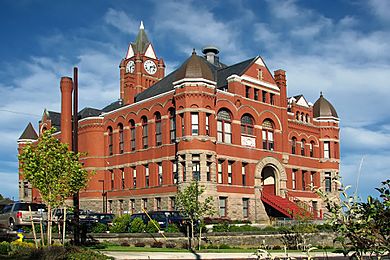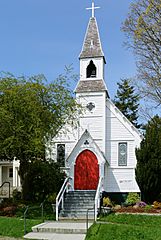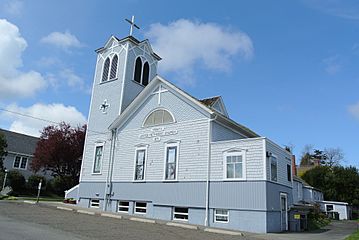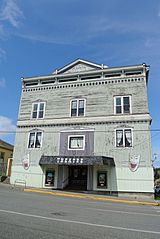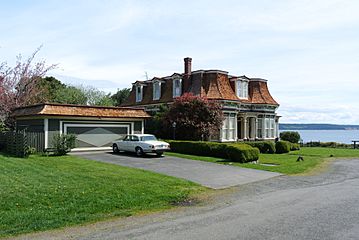Port Townsend Historic District facts for kids
|
Port Townsend Historic District
|
|

Barthrop House, now the Quimper Inn
|
|
| Lua error in Module:Location_map at line 420: attempt to index field 'wikibase' (a nil value). | |
| Location | Roughly bounded by Scott, Blaine, Walker, and Taft Sts., and the Waterfront, Port Townsend, Washington |
|---|---|
| Area | 200 acres (0.81 km2) |
| Built | 1858 |
| Architectural style | Mid 19th Century Revival, Late 19th And 20th Century Revivals, Late Victorian |
| NRHP reference No. | 76001883 |
Quick facts for kids Significant dates |
|
| Added to NRHP | May 17, 1976 |
| Designated NHLD | May 5, 1977 |
The Port Townsend Historic District is a special area in Port Townsend, Washington. It's known for its many old buildings from the late 1800s. This district is so important that it's been named a National Historic Landmark. This means it's recognized as a place that tells a big part of America's story.
The buildings here are very well-preserved. This happened because of a building boom (lots of construction) and then a sudden crash in the 1880s. The crash meant that new buildings weren't put up, and old ones weren't torn down. This makes Port Townsend one of the best examples of a late 19th-century port town on the West Coast.
Contents
A Look Back: Port Townsend's History
Port Townsend is located at the top of Washington's Olympic Peninsula. It started growing around 1850. Its location was perfect because it had a safe, deep harbor. This harbor was at the meeting point of the Strait of Juan de Fuca and the Admiralty Inlet. These waterways lead into Puget Sound.
The town quickly became a major place for customs. Ships had to check in here. It was also a key spot for shipping lumber from the nearby forests.
The Big Building Boom
In the late 1880s, Port Townsend experienced a huge building boom. Local business owners believed a railroad would connect the city to Portland, Oregon. This idea made them very excited!
The town's population grew fast. It went from less than 1,000 people in 1880 to about 4,500 by 1890. At the peak of this boom, it's thought that 7,000 to 8,000 people lived there. People even built enough homes for 20,000 residents! They were very hopeful about the future.
The Sudden Crash and Preservation
However, the building boom ended suddenly in 1890. The company planning the railroad went bankrupt. This meant the railroad was never built.
The town's population quickly dropped to about 2,000. It grew slowly over the next century. Because the economy fell so fast, and there wasn't a new industry to replace it, most of the beautiful Victorian buildings were saved. They weren't torn down or heavily changed. They were like "time capsules" for 100 years. Later, people realized how valuable these intact buildings were.
Exploring the Historic District
The historic district covers about 200 acres. It's on the southeast side of the downtown area. The district includes around 700 homes and 60 commercial and civic buildings.
Notable Buildings and Styles
You can find the city hall, built in 1891, and the Jefferson County Courthouse here. The courthouse is a beautiful building from 1892. It shows off the Queen Anne and Romanesque styles of architecture.
Many of the homes in the district are two-story wooden houses. They are often built in the Queen Anne style. This style has lots of decorative details. You might also see homes in the Stick or Eastlake styles, which are similar.
The commercial buildings are usually two to four stories tall. They are often made of brick with stone decorations. Besides the courthouse, there are other great examples of the Romanesque style. This style became popular around that time.
Three other buildings in Port Townsend are also listed on the National Register of Historic Places. These are the Capt. Enoch S. Fowler House, the Rothschild House, and St. Paul's Episcopal Church.
Images for kids


